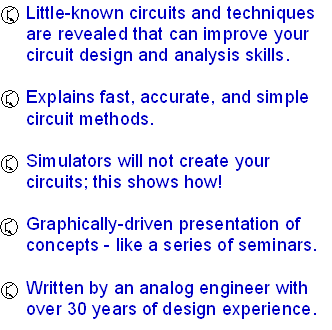Amplifier Circuits
Quasistatic circuits: Transistor T model,
configurations, transresistance method, input and output resistance,
b-e shunt R, cascade, cascode, Darlington, emitter-coupled stages,
current mirrors, feedback circuits
and analysis procedure, reduction theorem, effect
of BJT and FET ro, powerful gain and impedance-finding
methods.
Dynamic Circuits: Reactance, time and frequency response, Bode plots, reactance charts, amplifier response characterization and compensation techniques, pole-zero movement, impedance gyrations above bandwidth, output load isolation, supply bypassing.
High-Performance Amplifiers
Bandwidth extension techniques, source-follower,
common-emitter, cascode, shunt-feedback, and
diff-amp compensation, precision and low-level amplification, noise,
distortion, crosstalk, isolation, thermal effects, temperature
compensation, current-feedback amplifiers, gain cells, multipliers,
autocalibration.
Waveform-Processing Circuits
Voltage references, current sources, filters,
hysteresis switches, clamps and limiters,
multivibrators and timing circuits, trigger, ramp, sweep and triangle-wave
generators, log and exp amplifiers and function generation, absolute-value
circuits, peak detectors, D/A, A/D, and V/F converters, time- and
frequency-domain sampling theory, sample-&-hold and switched-C circuits.
